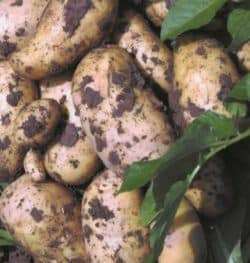Potato Fertilizer and Growing Guide
Okay, so chances are there will never be another event like the 1845-1852 Great Hunger. And to be quite honest, a bucket of Organic Potato Fertilizer isn’t going to do much of anything to prevent phytophthora infestans from destroying an entire nation’s food supply. However, it will make your plants healthier, and healthy plants are more resistant to blight. In this two part article, we are going to go over some of the basics of potato care. If you are a more experienced farmer, go ahead and skip down to part two where we discuss specific application rates of Natural Fertilizers.
Seed Potato Preparation
Before site preparation, you should go ahead and get your seed potatoes ready to plant a few days in advance. Cut larger potatoes into smaller pieces, being sure to include at least 1-2 eyes on each section. I recommend a light dusting of sulfur to prevent rot before placing them in a cool, dark place to encourage green growth. A brown paper bag with a few ventilation holes usually does the trick. Just be sure they do not get too damp or it might cause rot in the places you cut.
Soil Preparation and Planting your Potato Crop
Potatoes are going to need a lot of loose soil to spread out and develop tubers underground. Thoroughly till the soil and create mounds to plant in. Later on, you will probably want to practice hilling, which is simply piling more soil around the growing plants. Hilling converts the stems you bury into roots and allows the plant to send out more tubers into the new soil. It’s a great way to increase yields over a long season. Hilling also helps with your weed control by burying new sprouts and denying them the sunlight necessary to survive. Follow your supplier’s planting guide, or simply plant your starter pieces every 12 inches in rows about three inches deep.
Sprouting and Growing your Potato Crop
Why is there a picture of blueberries? Keep reading! Give your potatoes about two weeks to send up stems and leaves before hilling. Hill up 2-3 inches every two weeks until harvest. In addition to all the aforementioned benefits, hilling will prevent your tubers from getting damaged by the sun.

Do not make the same mistake I made with my blueberries one year. I added sulfur to the soil expecting the pH to drop. When it didn’t drop, I added more. Three months later and all my blueberries were dead. That’s right. You see those nice blueberries on this page? Gone! There was so much acid that you could stick two wires in the ground to jump start your car! Lesson learned. Be cautious applying sulfur!

Potato Fertilizer Guide
Banded Application of Organic Fertilizer for Potato Crops
Soil Application of Liquid Organic Fertilizer for Potato Crops
If you like what you read, feel free to share! Please be kind and link back to us if you republish this article.

